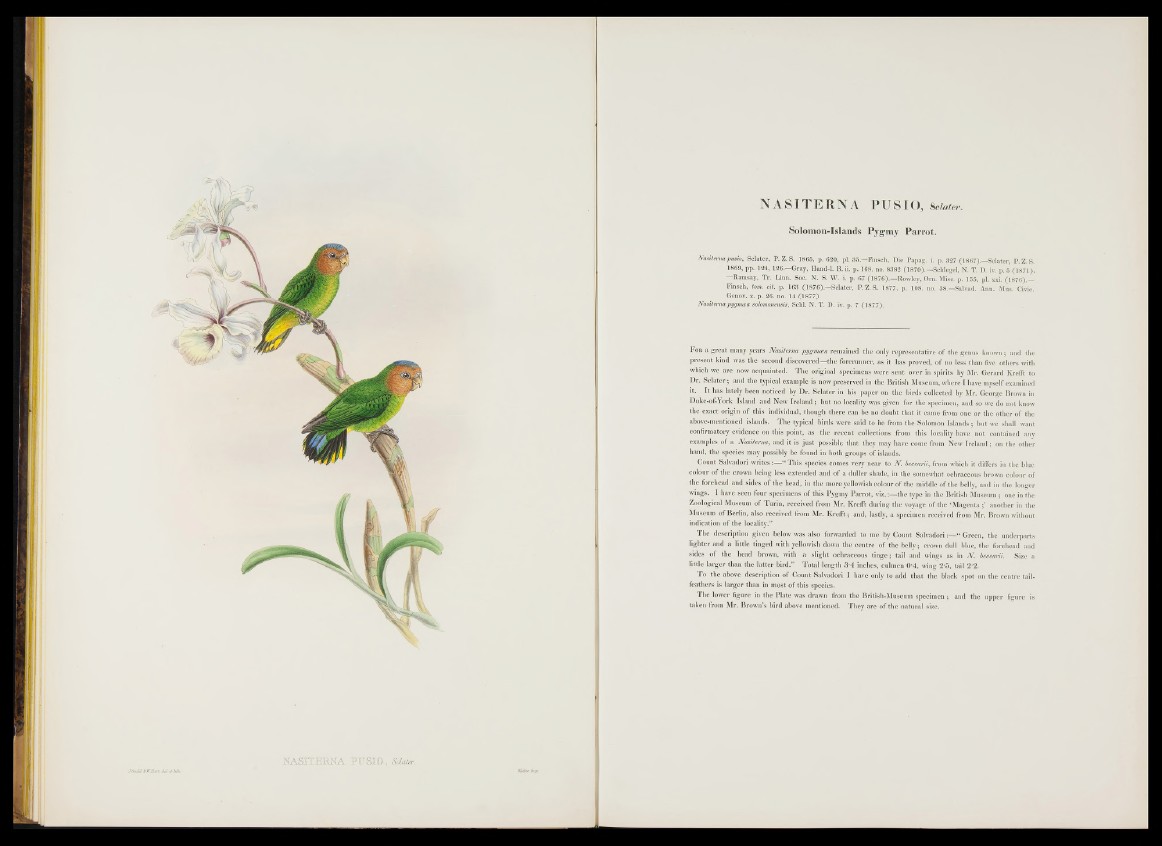
J.Gmt& bW-Hart, dd/ebhth/.
ITASITEKHA PU S IQ , Sdccter.
NASITERNA PUS 10, Sclater.
Solomon-Islands Pygmy Parrot.
Nasitermpusio, Sdatev, P. Z. S. 1865, p. 620, p l ,3 5—Finsch, Die Papag. i. p. 327 (1867).—Sclater, P.Z.S.
1869, pp. 124, 126.—Gray, Hand-1. B. ii. p. 168. no. 8382 (1870).—Schlegel, N. T. D. ir. p. 5 (1871),
—Ramsay, Tr. Ltan. Soc. N. S. W. i. p. 67 (1876).—Rowley, Om. Mise. p. 155, pl. xxi. (1876).—
FmsSh, tarn. eil. p. 163 (1876).—Sclater, P. Z. S. 1877, p. 108. no. 38.—Salvad. Ann. Mus. Clvic.
Genov. x. p. 26. no. 14 (1877).
Nasiterna pygrruea solomonensis, Sehl. N. T. D. iv. p. 7 (1877).
F o r a great many years Nasiterna pygmcea remained the only representative o f the genus known ; and the
present kind was the second discovered—the forerunner, as it has proved, o f no less than five others with
which we are now acquainted. The original specimens were sent over in spirits by Mr. Gerard Krefft to
Dr. S c la te r; and the typical example is now preserved in the British Museum, where I have myself examined
it. It has lately been noticed by Dr. Sclater in his paper on the birds collected by Mr. George Brown in
Duke-of-York Island and New I re lan d ; but no locality was given for the specimen, aud so we do not know
the exact origin o f this individual, though there can be no doubt that it came from one o r the other o f the
above-mentioned islands. The typical birds were said to be from the Solomon Islan d s; but we shall want
confirmatory evidence on this point, as the recent collections from this locality have not contained any
examples o f a Nasiterna, and it is ju st possible th at they may have come fi "om New Ireland ; on the other
hand, the species may possibly be found in both groups o f islands.
Count Salvadori writes :— “ This species comes very near to N. beccarii, from which it differs in the blue
colour o f the crown being less extended and of a duller shade, in the somewhat ochraceous brown colour of
the forehead and sides o f the head, in the more yellowish colour of the middle o f the belly, and in the longer
wings. I have seen four specimens o f this Pygmy Parrot, v i z . t h e type in the British Museum ; one in the
Zoological Museum of Turin, received from Mr. Krefft during the voyage o f the ‘M ag en ta ;’ another in the
Museum o f Berlin, also received from Mr. Krefft; and, lastly, a specimen received from Mr. Brown without
indication o f the locality.”
T he description given below was also forwarded to me by Count Salvadori:— “ Green, the underparts
lighter and a little tinged with yellowish down the centre o f the belly; crown dull blue, the forehead and
sides o f the head brown, with a slight ochraceous tin g e ; tail and wings as in N. beccarii. Size a
little larger than the latter bird.” Total length 3 4 inches, culmen 0-4, wing 2 5 , tail 2-2.
T o the above description o f Count Salvadori I have only to add th at the black spot on the centre tail-
feathers is larger than in most of this species.
The lower figure in the Plate was drawn from the British-Museum specimen; and the upper figure is
taken from Mr. Brown’s bird above mentioned. They are o f the natural size.